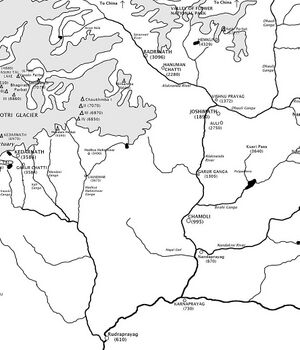Garur Ganga
| Author:Laxman Burdak, IFS (R) |

Garur Ganga (गरुड़ गंगा) is a tributory of Alaknanda and meets it at village Garur (गरुड़) town in the Bageshwar district of the state of Uttarakhand, India.
Variants
- Garur (गरुड़)
Location
Garur is about 16 km away from Kausani. From Garur about 25 km is Gwaldam which comes in Garhwal. Garur town spreads in a vast valley formed by glaciation and river erosion of Gomati and Garur Ganga. Nearby places include Kausani, Baijnath, Kot Bhramari Gwaldam and Bageshwar. The neighbouring villages also include Garhsher,Matena, Gagrigol, Chitrapal, Tilsari, Salani, Mattee, Bheta, Lobanj, Dangoli, Wajula, Dhaina. Some of villages nearby Garur are Silli, Amoli, Matena (Joshikhola), Darsani, Anna, Paye, Jijoli, Bhagartola, Dyonai, Motisyari, Baijnath, Shemar and Kajuli.
History
The regions around Garur are characterised by several historical sites mainly Temples, Naulas and various other archeological remains. It has the historical privilege of once being the capital of Katyuri Dynasty that ruled over the Kumaon region during 13th and 14th century.
Around 5–6 km from Garur there is a temple of Bhagwati Mata (Kot Ka Mandir) (traces of Ma Bhramri can be found in the last two paragraph of Chapter Eleven of Durga Shaptashati Path), which once was a fort owned by the Katyuri Kings. The guru Adi Shankar stayed on this temple while en route to Badrinath while coming back from Pataal Bhuwneshwar and earlier closing the ears of Lord Shiva at Jageswar in the same entour. Nearby, the Chakrwarti samraat Arun also use to come from a hole from Paataal (near the village of Garhsher) as cited in Durgasaptsati Yad Arunkhy Mahaabaadhaa Karoti Tadaa Aham ashankhy shatpadam and will kill that Mahaasuram. There is widespread belief among the local populace that the face of the goddess Kot Bhramri Devi, should not be shown to anyone except the priest of the temple. It is said that if this advice is not followed, the entire Katur Valley will face ill luck and a massive disaster will follow. Hence only the rear side of the goddess is worshipped, except during the annual festival of "Nandaashtmi" during Bhadrapad Ashtami or Radha Ashtami during September month (the state government declares as State holiday) or when the Raj Jaat Yatra which takes place once in twelve years. In the last 150 years, buffalo and lamb used to be sacrificed in the name of Nandaashtami. However, this practice has been stopped by The Honorable High Court of Nainital on a Public Interest Litigation filed by the Animal Protection Society; it is enforced by police protection. Though the Goddess Ma Bhramri is Satvik but some 200 years back during the Nepalese invasion and their kingdom, local deity Ma Nandadevi's status was installed at Kot Bhramri Mandir as a result animal sacrifice began two centuries earlier.
The temple of Baijnath (Lord Shiva) on the bank of the river is said to have been built by the Kumaon Katyuri king in around 1150 A.D. and it was Capital of the Katyuri dynasty of kings who ruled Uttaranchal during 12th and 13th century, Baijnath was once known as Kartikyapura. One of the most important places to visit in Baijnath is the historically and religiously significant Baijnath Temple constructed in the twelfth century. The temple holds significance because, according to Hindu mythology, Lord Shiva and Parvati were married at the confluence of River Gomati its other name in Hindu mythology known as GOMI River. It originated from Aana village path of the Kausani. Known as Pinath Velly. Here, Lord Shiva huge temple called Pinath Mandir) and Garur Ganga. Dedicated to Siva Vaidyanatha, the Lord of Physicians, the Baijnath temple is actually a complex of temples built by the Katyuri kings with the idols of Shiva, Ganesh, Parvati, Chandika, Kuber, Surya and Brahma. Also the town of Baijnath draws its name from the temple. Situated on the left bank of the Gomti River at an elevation of 1,126 m above sea, The stone carved temple that houses a beautiful idol of Parvati is chiselled in black stone. The temple is approached from the riverside by a flight of steps made of stones constructed by the orders of a Katyuri queen. On the way to the main temple, just below the house of the Mahanta, is the temple of Bamani. Legend goes that the temple was built by a Brahmin woman and dedicated to Lord Shiva. There is also a famous Ram Mandir Gali in main market. Garur named after a famous temple of God Ram where practice for Rameela takes place each and every year. the lone idol of mighty god Garur is situated in main Garur market, by the name of whose this area is known.
गरुड़ उत्तराखण्ड
गरुड़ उत्तराखण्ड राज्य के बागेश्वर जनपद में स्थित एक नगर पंचायत है। यह गरुड़ तहसील का मुख्यालय भी है, जिसके अंतर्गत जनपद के कुल 190 ग्राम आते हैं। अल्मोड़ा-बैजनाथ-कर्णप्रयाग मार्ग पर स्थित गरुड़ बैजनाथ से लगभग 1 किलोमीटर, कौसानी से 15 किलोमीटर, और बागेश्वर से लगभग 20 किलोमीटर की दूरी पर स्थित है।
गरुड़ कस्बा एक घाटी के मध्य में गरुड़ गंगा के तट पर बसा है। गरुड़ में ही लतोलिया गधेरा गरुड़ गंगा में गिरता है। भूगर्भीय रूप से, क्षेत्र को कम हिमालयी टेक्टोनिक जोन द्वारा दर्शाया जाता है।
External links
References
Back to Rivers

